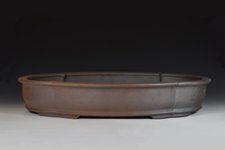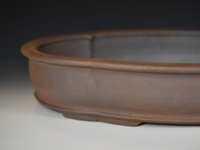NaoTK
Chumono
This thread is capturing my progress on duplicating Yixing pottery using local Oregon clay combined with modern Tokoname-style press molds.
Let me start with the punchline and then do a Quentin Tarantino.
Below is a 20" lotus pot made of clay I mined and processed in Oregon. The clay is unburnished and fired to cone 9R.



The clay
You may have seen my earlier posts on Yixing clays. While I was successful in making serviceable clays, I was not satisfied that they came from bags of imported clay from Florida, Kentucky, California, and Canada etc. So I've been inspired by @sorce and reading about potters in Japan and China, how they can just dig below their rice field and find usable high fire clay. Clay that is unique to a place and cannot be reproduced from imported bags.
Where I live near Portland, the clay is not suitable for pottery due to the low alumina content and various geological reasons I wont go into. Most river clays are actually not suitable for high fire pottery. As it turns out, there are a few locations in Oregon where there are kaolinic clay deposits that are refractory enough for high fire.
At one such spot there is both low iron kaolinite (the white stuff) and bands of iron-stained clay (the orange stuff)


I took samples of the clay home and there were basically three types at this particular mine.
1. The white stuff is kaolinite, it is 35%+ alumina
2. The purple stuff is ~8% iron and ~25% alumina
3. The orange stuff is ~5%-10% iron and ~30% alumina

I made test tiles using the clays by grinding them and passing them through a 100 mesh sieve.
(I bumped up brightness and contrast to more accurately match reality.)
Left: perfect reproduction of Yixing clay based on chemical analysis of pottery shards. It is smooth, plastic, and looks great at cone 6R
Top middle: 100% purple stuff processed and fired to cone 10. It is highly refractory, but it did vitrify where the reduction was heavy. It also holds a burnish really well.
Bottom middle: 100% orange stuff process and fired to cone 10. It is super refractory. Not even close to maturing.
Right: Purple stuff rebalanced to mature at cone 10. The color was not altered but the feldspar additions have diluted it

The lotus pot above is made of the purple stuff after rebalancing for cone 10. It has fine speckles of what may be iron or maybe even manganese. There were tiny but very hard silica crystals that I was unable to grind. This clay did not take a burnish well because the particle size was not very fine. I also did not settle the clay in water to improve plasticity, but since I was using a press mold this was not a huge concern.
Future work:
Let me start with the punchline and then do a Quentin Tarantino.
Below is a 20" lotus pot made of clay I mined and processed in Oregon. The clay is unburnished and fired to cone 9R.



The clay
You may have seen my earlier posts on Yixing clays. While I was successful in making serviceable clays, I was not satisfied that they came from bags of imported clay from Florida, Kentucky, California, and Canada etc. So I've been inspired by @sorce and reading about potters in Japan and China, how they can just dig below their rice field and find usable high fire clay. Clay that is unique to a place and cannot be reproduced from imported bags.
Where I live near Portland, the clay is not suitable for pottery due to the low alumina content and various geological reasons I wont go into. Most river clays are actually not suitable for high fire pottery. As it turns out, there are a few locations in Oregon where there are kaolinic clay deposits that are refractory enough for high fire.
At one such spot there is both low iron kaolinite (the white stuff) and bands of iron-stained clay (the orange stuff)


I took samples of the clay home and there were basically three types at this particular mine.
1. The white stuff is kaolinite, it is 35%+ alumina
2. The purple stuff is ~8% iron and ~25% alumina
3. The orange stuff is ~5%-10% iron and ~30% alumina

I made test tiles using the clays by grinding them and passing them through a 100 mesh sieve.
(I bumped up brightness and contrast to more accurately match reality.)
Left: perfect reproduction of Yixing clay based on chemical analysis of pottery shards. It is smooth, plastic, and looks great at cone 6R
Top middle: 100% purple stuff processed and fired to cone 10. It is highly refractory, but it did vitrify where the reduction was heavy. It also holds a burnish really well.
Bottom middle: 100% orange stuff process and fired to cone 10. It is super refractory. Not even close to maturing.
Right: Purple stuff rebalanced to mature at cone 10. The color was not altered but the feldspar additions have diluted it

The lotus pot above is made of the purple stuff after rebalancing for cone 10. It has fine speckles of what may be iron or maybe even manganese. There were tiny but very hard silica crystals that I was unable to grind. This clay did not take a burnish well because the particle size was not very fine. I also did not settle the clay in water to improve plasticity, but since I was using a press mold this was not a huge concern.
Future work:
- Buy a ball mill to speed up clay manufacturing and achieve finer mesh
- Try pond settling once I can increase clay production
- Make and fire with saggars
- Optimize recipe to enable burnishing
- Try out my awesome new mold designs

